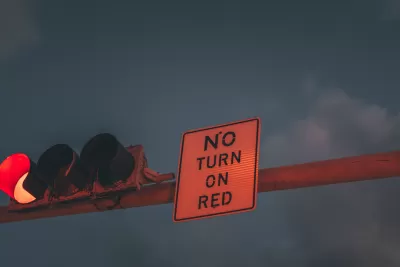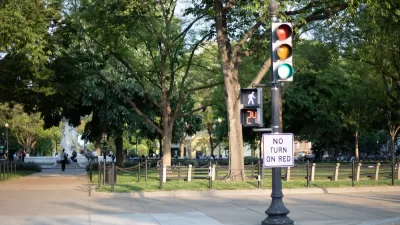Created in the 1970s to help boost gas mileage (with little proof that it had the desired effect), turning right on red creates dangerous situations for pedestrians and cyclists.

In an article in Fast Company, Aimee Rawlins argues that “Right-on-red is an ill-conceived traffic rule that needs to die.” As Rawlins explains, “The policy harms even those pedestrians and cyclists who avoid being struck, forcing them to maneuver around cars that have edged into crosswalks.”
Turning right on red wasn’t always legal on U.S. roads. “Until 50 years ago, only a handful of Western states permitted drivers to turn at a red light. But the 1970s oil crisis prompted the federal government to insist that states change their traffic laws, hoping that right-on-red would reduce gas consumed while cars idle at traffic lights.”
After the policy went into place, “A 1982 study found that the new policy triggered a sharp increase in crashes involving conflicts between a pedestrian or cyclist and a right-turning vehicle. In Ohio, for instance, such collisions rose 57% for pedestrians and 80% for cyclists; in Wisconsin, the figures were 107% and 72%, respectively.”
Turning right on red also frequently forces drivers into the crosswalk, says Bill Schultheiss of Toole Design. “That means you’ve denied the right-of-way to somebody walking or biking because a driver is blocking their path,” Schultheiss adds.
“Since the federal government created much of the current mess with right-on-red, it would be sensible for Congress and the U.S. Department of Transportation to help clean it up” by linking right-on-red regulations to grant funding, for example. “For the moment, the most viable path for dropping right-on-red goes through cities that control their own traffic rules.”
FULL STORY: It’s time to ban ‘right-on-red’

Planetizen Federal Action Tracker
A weekly monitor of how Trump’s orders and actions are impacting planners and planning in America.

Congressman Proposes Bill to Rename DC Metro “Trump Train”
The Make Autorail Great Again Act would withhold federal funding to the system until the Washington Metropolitan Area Transit Authority (WMATA), rebrands as the Washington Metropolitan Authority for Greater Access (WMAGA).

The Simple Legislative Tool Transforming Vacant Downtowns
In California, Michigan and Georgia, an easy win is bringing dollars — and delight — back to city centers.

The States Losing Rural Delivery Rooms at an Alarming Pace
In some states, as few as 9% of rural hospitals still deliver babies. As a result, rising pre-term births, no adequate pre-term care and "harrowing" close calls are a growing reality.

The Small South Asian Republic Going all in on EVs
Thanks to one simple policy change less than five years ago, 65% of new cars in this Himalayan country are now electric.

DC Backpedals on Bike Lane Protection, Swaps Barriers for Paint
Citing aesthetic concerns, the city is removing the concrete barriers and flexposts that once separated Arizona Avenue cyclists from motor vehicles.
Urban Design for Planners 1: Software Tools
This six-course series explores essential urban design concepts using open source software and equips planners with the tools they need to participate fully in the urban design process.
Planning for Universal Design
Learn the tools for implementing Universal Design in planning regulations.
Smith Gee Studio
City of Charlotte
City of Camden Redevelopment Agency
City of Astoria
Transportation Research & Education Center (TREC) at Portland State University
US High Speed Rail Association
City of Camden Redevelopment Agency
Municipality of Princeton (NJ)





























